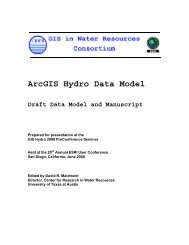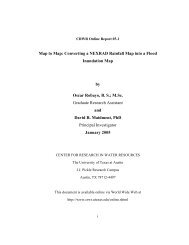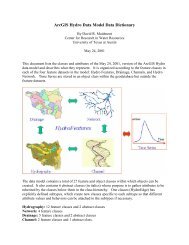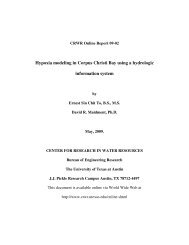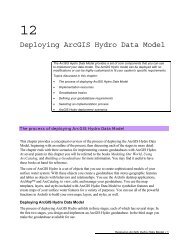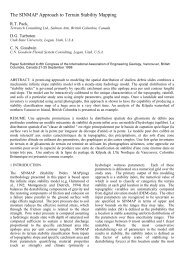View the Whole Report - Center for Research in Water Resources ...
View the Whole Report - Center for Research in Water Resources ...
View the Whole Report - Center for Research in Water Resources ...
You also want an ePaper? Increase the reach of your titles
YUMPU automatically turns print PDFs into web optimized ePapers that Google loves.
Flow per Area, cm/s<br />
40<br />
30<br />
20<br />
10<br />
0<br />
y = 22.322x 0.457<br />
R 2 = 0.9981<br />
0 0.1 0.2 0.3 0.4 0.5 0.6<br />
Level, m<br />
Figure 5.9 Flow vs. Head <strong>for</strong> Belton Woven Fabric (not vacuumed)<br />
root of <strong>the</strong> head. The data observed <strong>for</strong> <strong>the</strong> permeameter tests show that <strong>the</strong> actual<br />
dra<strong>in</strong>age behavior lies somewhere between <strong>the</strong>se two cases. At <strong>the</strong> low heads used <strong>in</strong><br />
ASTM D 4491, 10-75 mm, <strong>the</strong> relationship between flow rate and head could be<br />
approximated by a l<strong>in</strong>ear function.<br />
The velocity through <strong>the</strong> fabric dur<strong>in</strong>g <strong>the</strong> permeameter test was calculated us<strong>in</strong>g<br />
<strong>the</strong> Amoco 2125 (3.3% open area), <strong>the</strong> fabric specimen area, and <strong>the</strong> permeameter flow<br />
rate. This velocity and a pore diameter (AOS = 850 µm), were used to calculate <strong>the</strong><br />
Reynolds numbers shown <strong>in</strong> Table 5.8.<br />
Table 5.8 Velocities and Reynolds Number <strong>for</strong> Flow Through Amoco Woven Fabric<br />
Head, m Q/A, cm/s Velocity, m/s Re<br />
0.05 1.8 0.54 459<br />
0.1 3.2 1.0 825<br />
0.2 4.8 1.4 1,230<br />
0.3 5.2 1.9 1,610<br />
0.4 7.2 2.2 1,860<br />
0.5 8.0 2.4 2,060<br />
0.6 8.7 2.6 2,230<br />
The transition from lam<strong>in</strong>ar flow occurs <strong>in</strong> subsurface flow when <strong>the</strong> Reynolds<br />
number exceeds 10 and <strong>in</strong> pipe flow when <strong>the</strong> Reynolds number exceeds 2,000.<br />
Turbulent flow through a geotextile will occur when <strong>the</strong> Reynolds number is between<br />
51




